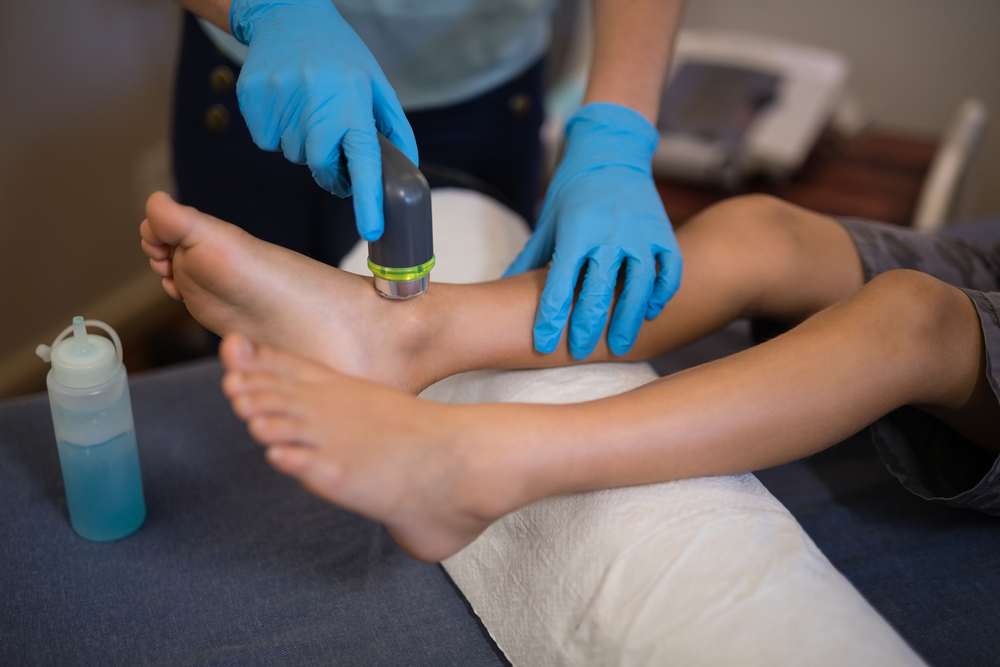Ultrasound treatment is a highly popular tool among podiatrists and physiotherapists, and is a versatile therapeutic method.
Ultrasound treatment is suitable not only for superficial foot injuries, but also for musculoskeletal conditions.
From tendonitis to chronic wounds and plantar fasciitis, this type of modern treatment makes it possible to tackle a wide range of painful ailments.
The ultrasound procedure uses a minimally invasive technology that adjusts to the patient’s needs.
Let us examine in which cases this therapeutic technique can be used and how it works on foot injuries.
The science behind ultrasound treatment
It is tempting to associate this form of care with alternative medicine. However, it is an effective procedure that has proven its worth in the treatment of many trauma-related pains.
But how does ultrasound affect the healing process of wounds?
Ultrasound treatment actually involves ultrasonic sound waves.
These waves can be transmitted over frequencies ranging from 85 kHz to 3 MHz.
Using a terminal and an applicator, the acoustic waves that penetrate the skin create a vibration.
This vibration of the treated area produces a soothing heat for the patient.
In addition to relieving pain, this treatment promotes better blood circulation and softens joint tissues like tendons.
What can be treated with therapeutic ultrasound?
One of the advantages of ultrasound therapy is the wide variety of physical ailments it helps to alleviate.
Some of the pathologies that ultrasound treatment can successfully treat include:
- Plantar fasciitis
- Morton’s neuroma
- Chronic lumbago (lower back pain)
- Osteoarthritis of the knee, hip and ankle
- Ankle sprains
- Achilles tendonitis
- Chronic wounds, such as foot ulcers in people with diabetes
- Ligament injuries
- A fracture that is difficult to repair
- Sports injuries
- Osteoarthritis of the big toe (hallux rigidus)
- Muscle spasms or muscle stiffness
- Scar adhesions
Of course, ultrasound treatment is rarely used as a single method of therapy.
In order to benefit from a comprehensive intervention, it is important to make a clear diagnosis, something that a visit to a clinic can provide you with.
The benefits of ultrasound therapy
In addition to the comfort it provides, ultrasound therapy has many advantages.
Among other things, ultrasound therapy makes it possible to:
Accelerate the body’s natural healing process
- Provide very accurate treatment by adjusting power and pulse frequencies
- Offer a promising alternative to invasive surgery
- Reduce swelling and inflammation
- Treat various pathologies quickly and painlessly
Procedure for ultrasound treatment
During a visit to your podiatrist or benchmark health professional, they should ensure that a diagnosis is made before proceeding with treatment.
This step in the therapeutic process is used to determine the problem area and the viability of ultrasound treatment for the patient.
Once the diagnosis is known, if your podiatrist chooses the ultrasonic acoustic wave method, the treatment will generally be carried out as follows:
- The frequency and tempo of the pulses are adjusted to the patient’s needs.
- The patient is asked to assume a position in order to facilitate the podiatrist’s access to the sore area.
- A conductive gel is applied to help distribute the waves to the deeper tissues.
- The treatment is administered, in continuous or pulsed mode according to the recommendations of the podiatrist.
Some types of injuries may take longer to respond to this form of treatment.
At this stage, it is your podiatrist who determines the necessary frequency of sessions and the treatment to be used in conjunction with the ultrasound treatment.
For example, to treat joint pain, your podiatrist may suggest a cortisone injection to the foot.
Contraindications and side effects
As with shockwave therapy and laser therapy, ultrasound treatment is not suitable for everyone.
While they are very effective in relieving several symptoms related to musculoskeletal problems, sound waves should not be used in the following situations:
- During pregnancy
- Pre-existing bleeding (internal and external)
- The wearing of electronic implants (which could overheat surrounding tissues)
- A skin disease such as psoriasis or foot eczema
- The presence of a malignant tumour near the area to be treated
- Circulatory disorders
- A purulent dermatological infection or lesion in the painful area
- Ossifying myositis (soft tissue ossification)
Contact your podiatrist if you believe you can benefit from ultrasound treatment and want to ensure that there are no contraindications to your condition.
Ultrasound treatment: a valuable complement to your foot therapy
Whether your podiatrist suggests manual foot therapy or a range of treatments, ultrasound treatment is an excellent addition to the primary therapeutic context.
When properly administered, this advanced technology provides effective and complete relief of pain caused by a wide range of problems.
Does foot pain prevent you from continuing your daily routine? Is a wound taking a long time to heal, and you’re worried it’s going to get infected?
Don’t wait any longer, contact your PiedRéseau clinic today.

